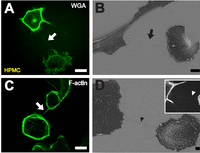
An Integrative Proteome-Based Pharmacologic Characterization and Therapeutic Strategy Exploration of SAHA in Solid Malignancies.
Sign Up to like & getrecommendations! Published in 2022 at "Journal of proteome research"
DOI: 10.1021/acs.jproteome.1c00791
Abstract: Targeting histone epigenetic modification is an important strategy for anticancer therapy. Histone deacetylase inhibitors (HDACis) have been clinically approved in the treatment of diverse hematological cancers, but mechanisms of drug resistance and poor therapeutic efficacy… read more here.
Keywords: saha; integrative proteome; strategy; drug ... See more keywords

Abstract 826: Histone Deacetylase Inhibition Improves Heart Failure With Preserved Ejection Fraction Cardiopulmonary Phenotype and Induces Metabolomic Switch
Sign Up to like & getrecommendations! Published in 2019 at "Circulation Research"
DOI: 10.1161/res.125.suppl_1.826
Abstract: Rationale: Approximately 50% of heart failure patients are diagnosed with Heart Failure with preserved Ejection Fraction (HFpEF), but there are currently no effective treatments. Hypothesis: Treatment of a feline HFpEF animal model with a pan… read more here.
Keywords: preserved ejection; failure preserved; heart failure; saha ... See more keywords

Suberoylanilide hydroxamic acid attenuates epidural fibrosis via inhibiting myofibroblast differentiation and increasing fibroblast apoptosis.
Sign Up to like & getrecommendations! Published in 2020 at "European review for medical and pharmacological sciences"
DOI: 10.26355/eurrev_202005_21364
Abstract: OBJECTIVE Epidural fibrosis represents a fatal stage of failed back surgery syndrome (FBSS) of known and idiopathic etiology, but no valid therapy is presently available. Previous evidence demonstrated that suberoylanilide hydroxamic acid (SAHA), a histone… read more here.
Keywords: fibrosis; apoptosis; epidural fibrosis; saha ... See more keywords

Suberoylanilide Hydroxamic Acid (SAHA) Treatment Reveals Crosstalk Among Proteome, Phosphoproteome, and Acetylome in Nasopharyngeal Carcinoma Cells
Sign Up to like & getrecommendations! Published in 2022 at "Frontiers in Genetics"
DOI: 10.3389/fgene.2022.873840
Abstract: Suberoylanilide hydroxamic acid (SAHA), a famous histone deacetylase (HDAC) inhibitor, has been utilized in clinical treatment for cutaneous T-cell lymphoma. Previously, the mechanisms underlying SAHA anti-tumor activity mainly focused on acetylome. However, the characteristics of… read more here.
Keywords: nasopharyngeal carcinoma; saha; suberoylanilide hydroxamic; acid saha ... See more keywords

Histone deacetylase inhibitors alter the expression of molecular markers in breast cancer cells via microRNAs.
Sign Up to like & getrecommendations! Published in 2018 at "International journal of molecular medicine"
DOI: 10.3892/ijmm.2018.3616
Abstract: Histone deacetylase inhibitors (HDACis) are able to suppress breast cancer cells in vitro and in vivo by altering the expression of estrogen receptor (ER), progesterone receptor (PR) or human epidermal growth factor receptor 2 (Her2/neu). Since HDACis can alter the expression of… read more here.
Keywords: her2 neu; bt474 cells; breast cancer; saha ... See more keywords

Suberoylanilide hydroxamic acid alleviates orthotopic liver transplantation-induced hepatic ischemia-reperfusion injury by regulating the AKT/GSK3β/NF-κB and AKT/mTOR pathways in rat Kupffer cells
Sign Up to like & getrecommendations! Published in 2020 at "International Journal of Molecular Medicine"
DOI: 10.3892/ijmm.2020.4551
Abstract: Multiple mechanisms are involved in regulating hepatic ischemia-reperfusion injury (IRI), in which Kupffer cells (KCs), which are liver-resident macrophages, play critical roles by regulating inflammation and the immune response. Suberoylanilide hydroxamic acid (SAHA), a pan-histone… read more here.
Keywords: akt; saha; ischemia reperfusion; akt mtor ... See more keywords